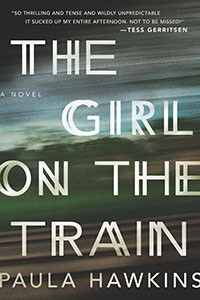Killer Memory
The Girl on the Train, Paula Hawkins’s debut thriller, is an enthralling tour de force
In her first thriller, The Girl on the Train, former British journalist Paula Hawkins has crafted a psychological thriller rich with complex personalities that prove to be as suspenseful as the masterful whodunit fueling the plot. Told from the shifting perspectives of three women, the tale unfolds as a tautly paced crime story about the disappearance of one of the narrators. For its unrelenting attention to human pathology, particularly the ways in which relationships sour, The Girl on the Train is the equal of Gillian Flynn’s hit, Gone Girl.
 This debut is a smart, addictive novel about flawed people desperate for connection—to each other, and to the truth. It is also a novel about the failure of memory. The chapters move from Rachel to Anna to Megan, although the story truly belongs to Rachel, who wrestles with her own unreliable memory in an effort to keep herself sane. And alive.
This debut is a smart, addictive novel about flawed people desperate for connection—to each other, and to the truth. It is also a novel about the failure of memory. The chapters move from Rachel to Anna to Megan, although the story truly belongs to Rachel, who wrestles with her own unreliable memory in an effort to keep herself sane. And alive.
In her early thirties, Rachel is a mess. A few years earlier, she had been happily married to a charmer named Tom, but fertility issues left Rachel depressed, and she began to drink heavily, frequently blacking out. Tom’s affair with Anna deepened her troubles. Divorced, lonely, and alcoholic, Rachel also loses her marketing job, but she hides the truth from her overly fretful roommate by maintaining her routine: “In the morning, I take the 8:04, and in the evening, I come back on the 5:56. That’s my train. It’s the one I take. That’s the way it is.”
 In London, Rachel hangs out in libraries, takes aimless walks, and drinks canned gin and tonics. She also becomes obsessed with Megan and her husband, strangers who live on the block where Tom now lives with Anna and their baby. Fixated on the strangers, Rachel imagines them as perfect. “They’re a match,” she thinks. “They’re happy, I can tell. They’re what I used to be, they’re Tom and me five years ago. They’re what I lost, they’re everything I want to be.”
In London, Rachel hangs out in libraries, takes aimless walks, and drinks canned gin and tonics. She also becomes obsessed with Megan and her husband, strangers who live on the block where Tom now lives with Anna and their baby. Fixated on the strangers, Rachel imagines them as perfect. “They’re a match,” she thinks. “They’re happy, I can tell. They’re what I used to be, they’re Tom and me five years ago. They’re what I lost, they’re everything I want to be.”
The truth about that couple, of course, is much darker. In her own chapters, Megan reveals deep unhappiness and long-held secrets. The night Megan goes missing, Rachel—intoxicated and angry—visits Tom and Anna. Later she remembers only snippets of what happened, but her conviction that she witnessed something terrible finally snaps her out of her alcohol-induced fog. Her obsessive voyeurism becomes a single-minded pursuit to uncover what’s become of Megan, though the police dismiss her as an unreliable witness entrapped by her own agenda. What Rachel doesn’t suspect is that illuminating the truth about Megan will force her to face her own demons.
Rachel makes for the best and most frustrating of protagonists: complicated, wounded, perhaps as good-hearted as she is self-destructive. Whenever she closes in on clarity, she sabotages her recollections with liquor. Through Rachel, Hawkins systematically disfigures the barrier between imagination and memory, fantasy and reality. The same is true for Megan, whose seemingly perfect life was lonely, and for Anna, who imagines that her life and marriage are ideal in every way except for Rachel’s relentless appearances and drunken phone calls.
The foremost delight of The Girl on the Train is its measured dismantling of fairy-tale lives. Instead of falling through a rabbit hole, Rachel must crawl her way out of the alcohol-fogged depths to reconcile present time with her own fractured memories—at the risk of losing not only her escapism but her life. Hawkins’s thriller is so ambitious in scope, so mature in its arc, and so unrelentingly specific in detail that it feels like the work of an experienced author. This is an extraordinary drama that’s rich with emotion and as cleanly executed as a killer shot.

Sarah Norris holds an M.F.A. in creative nonfiction from Sarah Lawrence College and has reviewed books for The Daily Beast, Christian Science Monitor, San Francisco Chronicle, and Village Voice, among other publications. She lives in Nashville.


